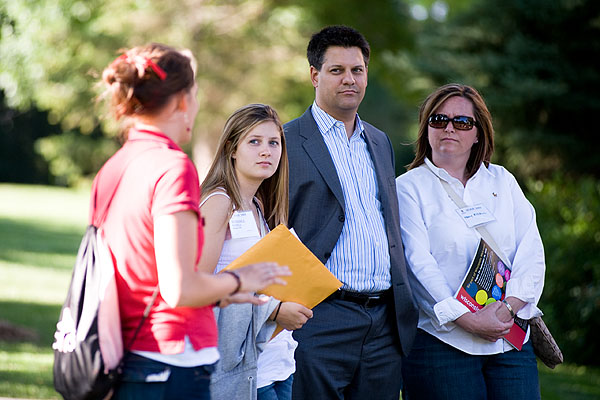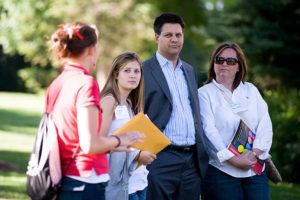College visits are an excellent way for students to check out schools that interest them and make sure that they feel the same about the colleges after seeing them up close. They can show your child what the college experience is like and generate enthusiasm for college generally. They can also pinpoint what sorts of colleges your student does or does not want (students, for example, may not initially know whether they have a distinct preference for a small liberal arts school, or a large state university). Encourage your child to visit colleges and make those visits happen, but let your child decide which colleges s/he wants to visit and what he or she wants to explore.
Make sure your student knows the various options out there, but let your student decide what he or she wants to see. Take the guided tour, but also encourage your child to check out various aspects of the college. If possible, students should see as many different facets as possible—sit in on a class (let them choose which), check out the student union, look into the library, eat lunch at the dining hall, meet with a prof., attend a game, etc. Allow your student to explore what interests him/her most and arrange your visit accordingly. (College admissions offices are great resources for planning your college visit, so contact them in advance to help make sure your student sees everything he or she wants to on your trip. If your student wishes to spend a night in a dorm, a good way to see what going away to college is like, the admissions office can also help you set up a stay for your student. If your student wishes to speak with a professor in his or her intended major, email the admissions office or have your child email the professor directly to ask for a brief visit to learn more about the college.)
Always let your student ask the questions first. S/he is the one going to college, and should make sure that the college is a place that s/he wants to go. Encourage your child to think of thoughtful questions to ask of people beforehand. (College websites are helpful for researching basic information about the college beforehand.) Feel free to ask your own thoughtful questions, too, but make sure that you do so only after students have asked their own. If your student is the type to be easily embarrassed, consider going on separate tours so that you can ask questions without causing tension with your child.
Encourage your student to speak to current students about their experiences; they can provide additional information to supplement what you learn on the college tour. If it is helpful, encourage your student to think about what he or she wants to ask before the trip.
Throughout the visit and afterwards, discuss how your student saw the college and what she learned from the visit. Start a genuine conversation (rather than trying to sway your child in the direction of this or that school) about the school by asking how he or she liked the class s/he sat in on, what she thought of the professor she met, what most excited him about attending, whether she could picture herself attending, what sort of impression he got from the students at the school, why she is interested in going there. Serving as a sounding board will help your student take stock of his or her impressions of the college and what s/he wants out of the college experience. Encourage your student to document the visit, or write up some notes as your student reflects. These reflections will be useful not only for discovering which schools best suit your student and where he or she wants to go, but they will also be helpful to refer back to when your student writes his “why this college” essay and makes a final decision on where to go to college.
Finally, always remember that the best place for your student is not necessarily the highest-ranked or best-known school. Rather, it is a place where your student will feel most comfortable and be challenged to grow academically and personally. In short, the student and the college will have matching interests and strengths. Let your student determine which schools those are.






